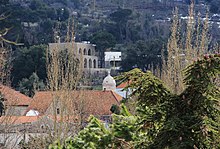Lebanese nationalism
[citation needed] It took its formalized form during the inter-war period and the French Mandate of Syria, when it served primarily as a tool in opposing Arab nationalism and in justifying the existence of the nascent country of Lebanon.
It was also present among the Shiite Muslims of the Amal movement and a central ideology of its armed wing, the Lebanese Resistance Regiments.
[4] As a result, Lebanese nationalists have never formed a bloc, being very different ideologically and having divergent opinions on which allies to choose, all adding up to confessionalism.
[5] That comes from the fact that present-day Lebanon, the Mediterranean coast of Syria, and northern Israel is the area that roughly correspond to ancient Phoenicia and so most Lebanese people identify with the ancient Phoenician population of that region.
[6] Therefore, the proposed Greater Lebanese country includes Lebanon, Mediterranean coast of Syria, and northern Israel.


